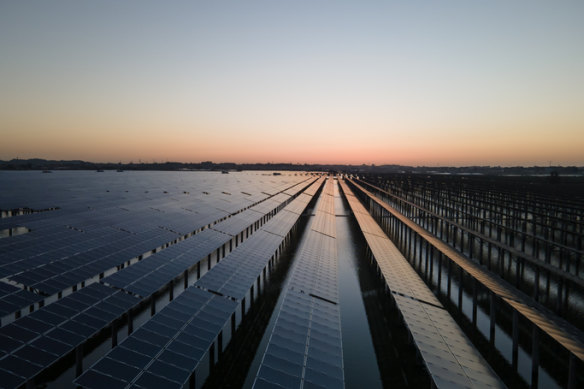- Sponsored
- Environment
- Sustainability
- BHP
Resources boom ‘critical’ for energy transition
Sponsored by BHP
Australia’s energy market operator has urged developers to speed up the construction of power transmission networks to support the country’s growing renewable energy capability, and reduce the risk of potential future blackouts.
At the recent Australian Financial Review Energy and Climate Summit, the energy market operator suggested developers tap into the support offered by government inventive schemes to get transmission network projects into construction, and work harder on getting the backing of local communities for new transmission projects.

Australia’s natural resources make the nation well placed to become a low-carbon emission energy superpower.Credit: iStock
Even so, Australia remains well placed to become a low-carbon emission energy superpower, not only because of our vast solar and wind resources but because of the critical minerals needed to construct this future around the world.
For example, on the transmission front, Bloomberg New Energy Finance (BNEF) highlights that the power grid globally would need to be 152 million kilometres in its net zero scenario – roughly the distance to reach the sun.
BNEF says huge investment is likely to be needed to extend transmission lines, cables and transformers, and also to upgrade power grids to support a wider variety of demand management as well as to connect all the dispersed renewable energy assets.
What’s more, onshore wind capacity is more than three times more steel intensive than gas-fired power generation, while the figure for offshore is five times more, according to analysis by BHP.
All of this translates to a huge demand for more steel and for the iron ore and better-quality metallurgical coal to be used in the manufacturing process, so the world can build the infrastructure it needs.
A recent paper The brown to green transition - Unleashing the energy transition published by BlackRock, one of the world’s leading providers of investment, advisory and risk management services, with insights and analysis from BHP, found output from the mining industry and its immediate customers will have to grow enormously to reliably provide the physical building blocks of the so called “brown to green” transition - from an energy system that’s carbon-intensive today to a world of deep electrification backed by a range of renewable, low or zero carbon-emission energy sources.
The publication found the mining sector will have to step up big time to provide the critical minerals and rare-earth elements needed in batteries for power and electric vehicles, the ore needed for the steel in wind turbines and power grid expansion, to fertiliser feedstocks required to boost agriculture yields for biofuels and more efficient land use.
Just looking at two critical minerals, BHP estimates that under its 1.5 degree scenario, over the next 30 years, cumulative primary copper demand globally would be double the amount consumed in the previous 30, and for primary nickel, it would be closer to fourfold.

BHP chief executive, Mike Henry.
According to BHP, these figures consider the amount that would need to be mined after netting out scrap volumes coming from recycling. It would be even bigger if the circular economy makes slower inroads than anticipated.
Speaking at the recent International Energy Agency Critical Minerals and Clean Energy Summit, BHP chief executive, Mike Henry, outlined some of the challenges ahead.
He said the world needs to significantly scale up supply of certain minerals needed to decarbonise the world’s energy system, which “is going to require significantly more of certain commodities, like copper, nickel, lithium and even steelmaking raw materials”.
He said BHP’s estimate under a plausible high case forecast for copper alone, the investment needed to satiate demand would be around $US250 billion in growth capital over the next seven years to 2030.
Unfortunately, currently committed growth projects over this period only amount to around $US40-50 billion, Henry said.
This means Australia must get its skates on and more projects need to be identified, permitted and given the green light by those who are to invest in them.
“Governments and communities need to be supportive of these projects progressing and capital providers need to be flowing the capital to those companies that uphold the high ESG standards that must be met,” Henry said.
These challenges can be overcome, but it will require shared perspective, common aspiration and a high degree of collaboration.
BHP, who is well placed to assist in the world’s energy transition across its global operations, is working hard to meet the demand for a number of the critical minerals needed while upholding its ESG standards.
For example, the company has made good progress towards meeting its 2030 target for reduction in its operational greenhouse gas emissions. A good local example is Queensland’s BHP Mitsubishi Alliance (BMA) which recently entered into a new renewable power purchase agreement (PPA) with Queensland’s publicly owned energy generator and retailer CleanCo.
The PPA is expected to provide half the forecasted electricity demand of BMA’s Central Queensland operations over five years from January 2026.
According to BHP president Australia, Geraldine Slattery, the company is “increasing renewable electricity at BMA in line with our decarbonisation commitments to 2030 and beyond, improving the long-term sustainability of our business while at the same time supporting Queensland’s renewable electricity infrastructure build, regional communities and local jobs”.

BHP president Australia, Geraldine Slattery.
“We expect demand for Queensland’s higher-quality metallurgical coal to remain strong for many years to come, as major steelmakers look to reduce their emissions intensity while delivering the steel needed to support global population growth and decarbonisation infrastructure.”
The new PPA will help support four renewable electricity projects across regional Queensland, which combined are expected to generate more than 1500 local jobs during construction.
CleanCo CEO, Tom Metcalfe says the company is “committed to providing tailored, clean energy solutions to help our customers decarbonise”.
“It is our role to develop solutions that meet the unique energy needs of these companies so that they can thrive in a net zero future and I am thrilled BMA has entrusted CleanCo to continue to supply reliable, renewable energy for its operations,” Metcalfe says.
Another PPA signed by BHP with renewable energy provider Neoen is expected to meet half of South Australia’s Olympic Dam’s electricity needs and allow Olympic Dam to record a net zero emission position for the contracted volume of supply.
The PPA is expected to supply 70MW of electricity to Olympic Dam and will help BHP produce copper more sustainably from the site.
Speaking on the PPA’s signing, Neoen’s chairman and CEO, Xavier Barbaro, said, “this first baseload PPA is a significant step forward for Neoen and will serve as a template for future contracts, opening up new market opportunities in Australia and in the rest of the world.”
To learn more, visit www.bhp.com.